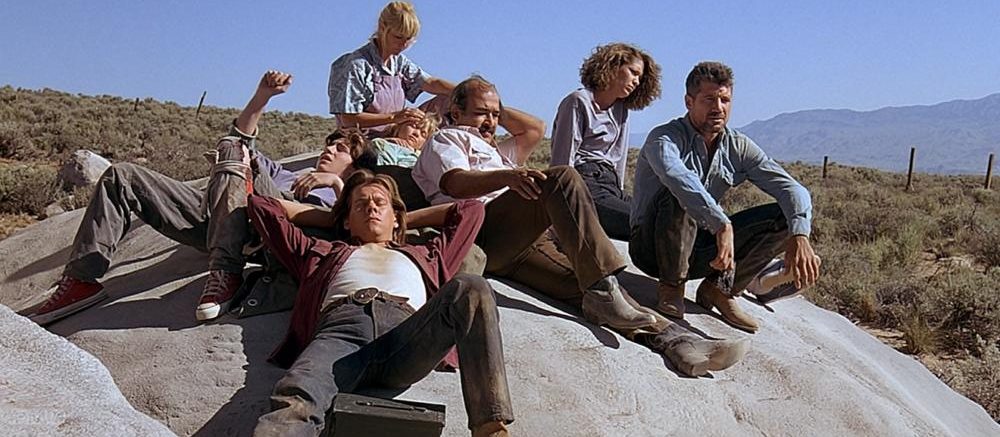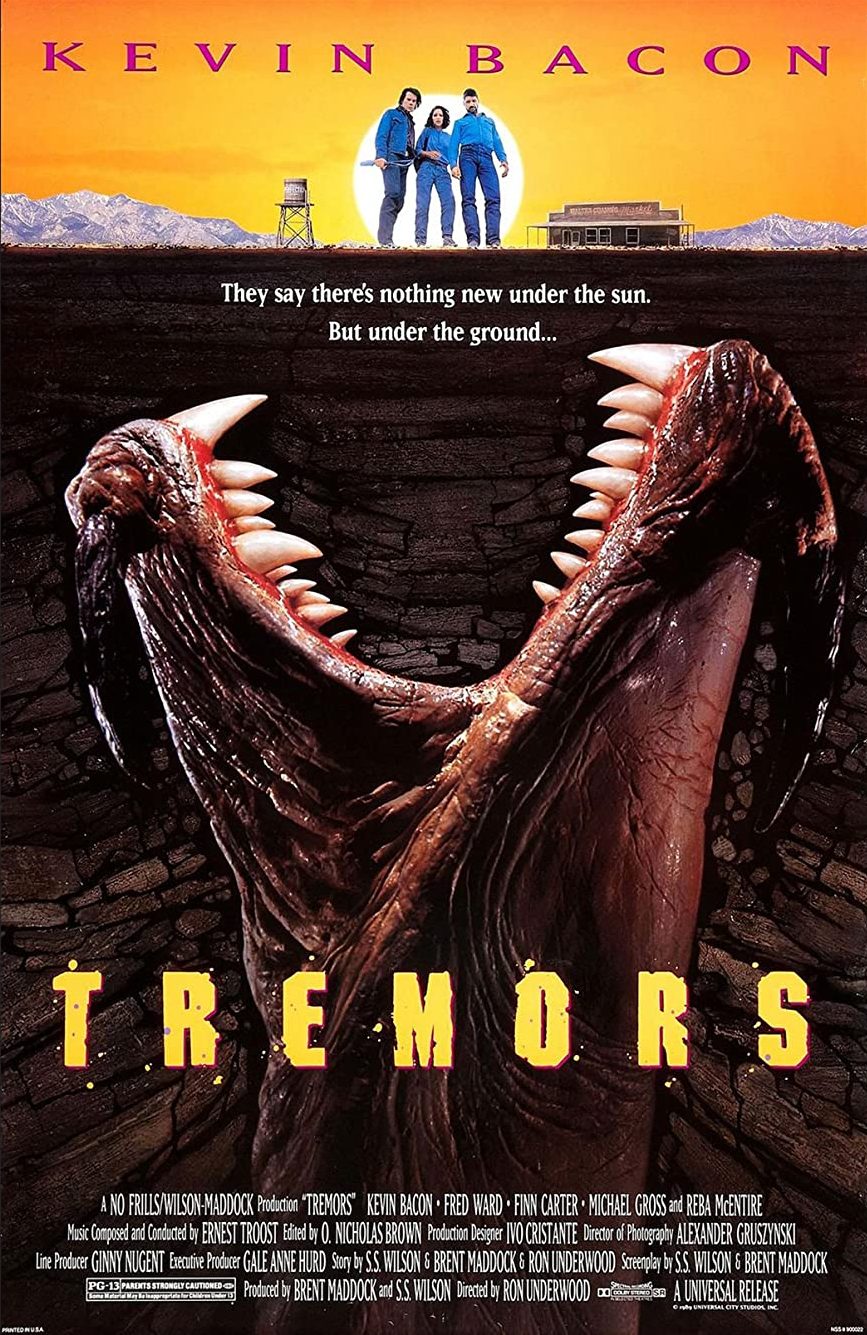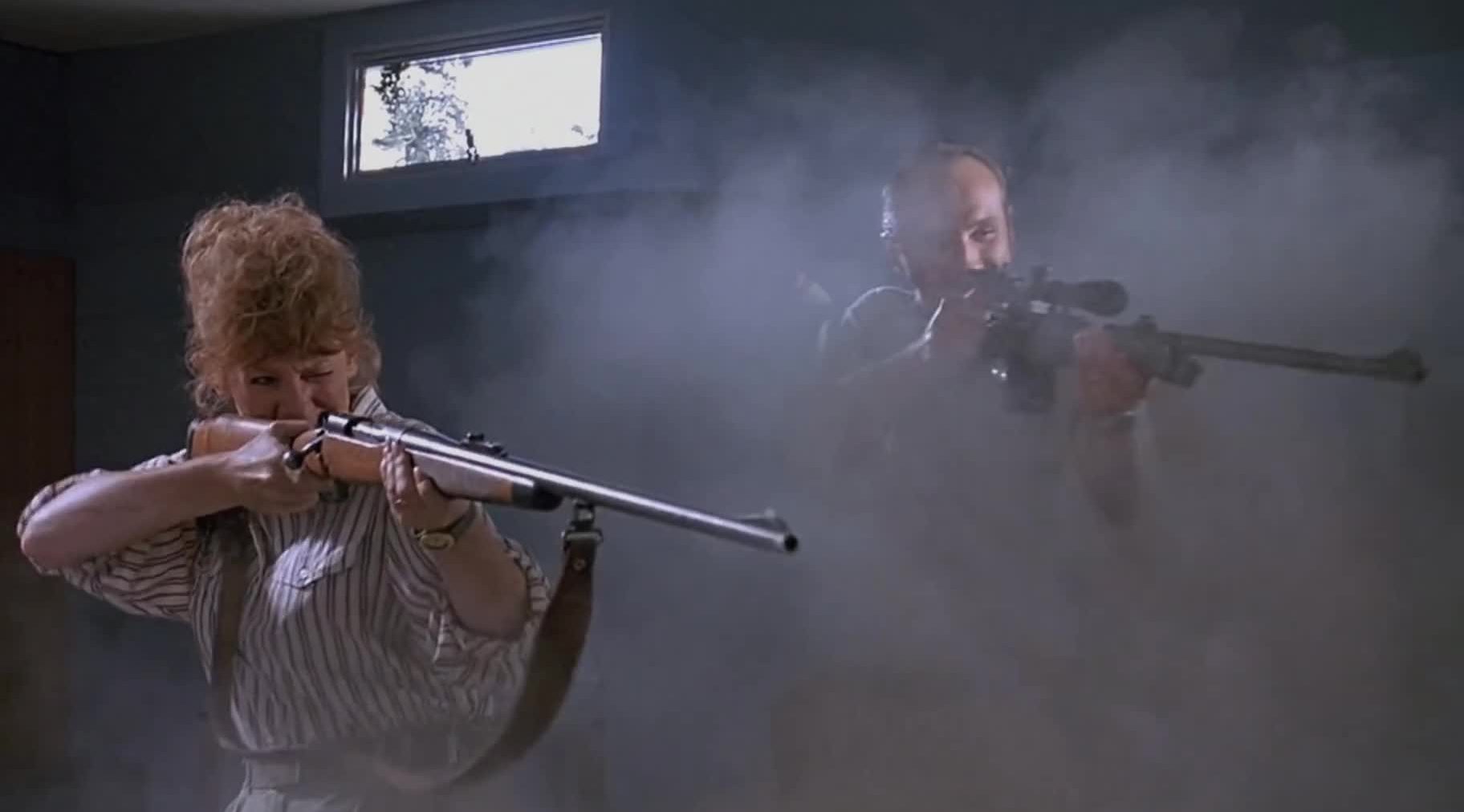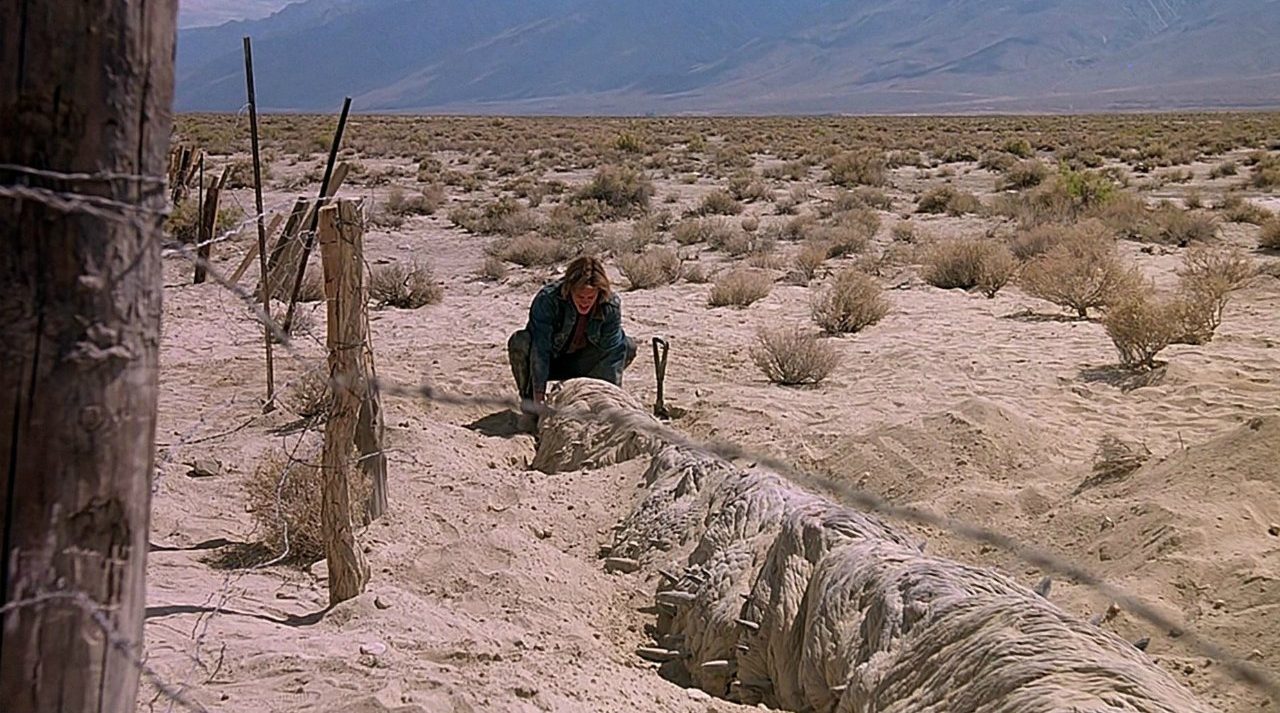

“I wouldn’t give you a gun if it were World War 3.”
Tremors is a B-movie that is much better than it should be. Don’t take that the wrong way. I love many films in the horror-comedy corner of cinema. Army of Darkness, They Live, Gremlins, etc. They’re not trying to appeal to the oftentimes pretentious cinephile crowd who look for nifty camerawork and creative storytelling, or want some social commentary that can be read into the film, but to a certain subsection of the culture that prefers blood and guts, cheap humor, and antics. It also never tries to convey any sort of social message like Shaun of the Dead or American Psycho (both of which probably tip the scale into being legit cinematic statements). Instead, it succeeds on charm, knowingly cheap practical effects, and a cast that balances a perfect line between serious and tongue-in-cheek; this balancing act allows the film to land squarely in the sweet spot of both scary and funny. Director Ron Underwood captures the essence of the schlocky B-movie and puts together a wonderfully endearing film.

Although Kevin Bacon stars as Valentine, the film works because the ensemble cast are all engaging and game for having fun with the outrageous script. Bacon has great chemistry with his co-star Fred Ward, who plays a character named Earl Bassett. The two rag on each other constantly and the older, more experienced Earl looks on with amusement as Valentine fumbles his way through romantic troubles with Rhonda (Finn Carter), a grad student studying seismic activity in the desert. The two handymen spend the early parts of the movie mentally putting dumpy Perfection, Nevada behind them and agreeing to leave (their sewer pump malfunctioning and covering them in human waste is the last straw). “I can’t believe we said no to free beer!” Valentine exclaims when they turn down a job offer and head for greener pastures.
But before they can make it out of town, they start discovering dead bodies. We get to witness a few of the deaths (fun, cheap, practical effects), while others are left to the imagination. They soon realize that the area has been invaded by a wormlike creature that senses vibrations in the ground and is hellbent on consuming human flesh. The townspeople quickly find themselves isolated and forced to fend for themselves.

One way in which Tremors differs from other cheese-laden horror films is that it doesn’t continue throwing bodies in the way of the monster to up a body count and overload the viewer with gore. Instead, once the threat is established, the small group remaining implicitly take a “no man left behind” stance. This evokes genuine concern in the viewer when there are close calls because none of these characters are “throwaway.” That’s not to say that there is much character development—there’s barely any, in fact—but each character is given sufficient material such that none feel superficial. Case in point is Chang (Victor Wong1), a general store owner with an entrepreneurial spirit who haggles a deal out of Val and Earl when they find one of the creature’s tendrils tangled around their truck axle, then starts selling polaroids to people who want a picture with it. He also has a laugh out loud moment when Val and Earl are going to head out on their own, handing supplies to them and saying, “Earl, here is some swiss cheese and some bullets.” Anyway, when a bearing in the refrigerator system at Chang’s store starts screeching and Chang’s feet move too slowly to get out of the way, we are not interested in seeing our main characters survive at the expense of Chang, but instead imploring them to turn around and wrest Chang from the creature’s mouth.
Additionally, while the film itself does not try to be “intelligent,”2 its characters are at least passably smart, adapting to new discoveries just as the monster adapts to their tendencies. They react believably within the context of the film and at no point do we have to look at our couchmate and say, “Why would they do that?! Are you serious?”

What really makes the film shine for me is its sense of humor. Its profanity is a bit excessive,3 but otherwise it is spot-on with its wit, timing, and mixture of content. There are physical comedy, jokes written into the script, spitballing camaraderie and banter that I have to assume was a result of the cast ad-libbing. A scene that will live on in the shared language between me and my wife takes place about two-thirds of the way through the film. Husband and wife Burt and Heather Gummer (Michael Gross and Reba McEntire), a gun-loving pair of survivalists predating the current prepper craze, are contemplating their course of action as the survivors sit trapped atop a few large rocks. Burt grimly tells his wife of his plan if things don’t soon turn for the better, and McEntire’s response and delivery were insanely hilarious (at least to us they were, anyway).
Burt: “If it comes to starvation, I know what I’m doing. Take one of these [homemade bombs], walk right out there with the fuse lit and let him take me down. Boom.”
Heather: “Good Lord, honey.”
Gross’s measured lines are almost all funny, from his calm response to Earl, who asks why he had cannon fuses to make homemade bombs (“What the hell do you use it for?” “My cannon.”) to his explanation of what is in the bombs to Val (“A few household chemicals in the proper proportions.”)
The film is more than a bit reminiscent of 1950s monster movies—The Blob, The Thing From Another World—but was released in the wake of Jaws, and so is easily viewed as a landlocked version of that film (albeit one with substantially less cinematic merit and self-seriousness but loads more humor). In fact, it’s original title was “Land Sharks” but they had to change it because Saturday Night Live already was already parodying Spielberg’s film with their own character of that name.

One of the primary difficulties of reviewing movies is trying to justify your natural reaction to them. It is easy to say “I liked it” or “I didn’t like it” in order to convey one’s assessment of its quality to another person. But to actually identify what things in the film worked and what didn’t can be challenging when something like Tremors comes along which includes many elements that typically don’t do it for me (or at least, don’t amount to something I love). Many films like this are like novelty items to me, where I’m more interested in why they became cult favorites or how they spawned franchises. But Tremors is more than a curiosity. It’s not a classic, but it’s a truly great film that I find myself rewatching more often than many films that I consider favorites. So no matter what I say, my actions prove that I really like this film.
1. I don’t know the specifics of how Wong chose which films he worked on (possibly he just took whatever roles were offered), but he acted in a trio of cult films early in his short career. In addition to Tremors, he also had prominent roles in Michael Cimino’s Year of the Dragon and John Carpenter’s Big Trouble in Little China.
2. By that I mean it is a straightforward story bereft of subtext which wishes only to entertain.
3. Interestingly, the film was originally given an R rating, after which the creators cut or overdubbed a bunch of f-bombs. So instead of additional profanity, we get amazingly cheesy lines like, “Be advised, however, that there are two more, repeat, two more motherhumpers,” and “Can you fly, you sucker?” which were funny before, but are more funny now that I know they were edited.
Sources:
Wilson, S.S. “Tremors FAQ”. Stampede Entertainment. 1 June 2016.
Mancini, Mark. “20 Fun Facts About Tremors”. Mental Floss. 19 January 2015.